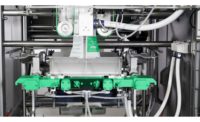Driven by demand for convenience, "better for you" ingredients and indulgence, the lines between meals and snacks have become increasingly blurred. Valued at an impressive US$137.2 billion in 2018, the savory snacks market is forecast to record a CAGR of 5.2 percent over 2018–2023, to reach US$176 billion by 2023.[1] The opportunity for manufacturers to capitalize on this growing trend is no doubt an exciting one. But as the snack market looks to shed its association with guilty consumption through the introduction of healthier ingredients and more sustainable processing and packaging, there is a need to evaluate the technology required to create the next generation of products that deliver nutritious and authentic snackable moments.
Here, we look at two of the most important trends for savory snacks in 2020 – health & wellness and sustainability, exploring the technology that will support manufacturers in redefining the market.
Health and wellness: a driving force
Snacking is growing in popularity as a convenient way to not only satisfy hunger but consume nutrient-rich food that supports mental and physical wellbeing. Traditionally associated with salty, high-fat foods, savory snack manufacturers are looking for ways to keep delivering the indulgence factor while providing healthier options that come without post-consumption guilt.
The nutritional profile of snacks is firing up the consumer agenda with products exhibiting health and wellness claims registering growth at a CAGR of 1.3% between 2013 and 2018.[2] Brands have an opportunity to capitalize on this demand with functional snacks that aid physical, cognitive, and emotional health.
Processing the technological implications of healthier snacks
When adjusting the nutritional profiles of savory snacks, the adoption of innovative processing techniques can make a real difference – from pre-processing and frying technology through to accurate seasoning methods. And with alternative ingredients coming to the fore, such as sweeteners and healthier oil varieties, ensuring equipment can handle such ingredients is an important consideration.
New ingredients and processes being adopted to make snacks healthier are having a significant impact on the use of frying technology. Frying methods have evolved to improve the health credentials of processed snack foods. Vacuum or batch frying, for example, has the potential to revolutionise the snack industry by creating healthier snacks with lower levels of fat and acrylamide — a potentially carcinogenic substance that occurs when starchy foods are cooked at high temperatures for a long time.
With vacuum frying, the frying vessel is enclosed, and pressure is reduced meaning that the boiling point of water is reduced to below 100 degrees Celsius. This means the product is cooked continuously at a low temperature, reducing the formation of acrylamide. The low temperature also means the degradation of the product’s surface structure is reduced, lowering the amount of oil absorbed – ultimately reducing fat content with minimal impact on product quality. Alternatively, when batch frying, the product is cooked for a longer amount of time at lower temperatures, reducing both the formation of acrylamide and oil absorption, creating a healthier end product.
By introducing alternative frying methods, manufacturers can simultaneously process alternative ingredients and raw materials. Fruit and vegetables, such as parsnips, beets and carrots, are typically high in natural sugars, which means they are prone to burning and acrylamide formation. Low temperature frying conditions, however, allow producers to meet consumer trends for healthier options. As such, fruit chips, like banana, kiwi and mango are becoming increasingly popular and have slowly started to replace snack varieties, increasingly perceived as “unhealthy”.
Meeting nutritional guidelines
While consumer influence is undoubtedly a driving force in the evolution of the snack market, health organisations are also putting a spotlight on snacking in a bid to reduce the impact of unhealthy choices when it comes to convenience foods. Many of the initiatives put forward focus on regulated portion control. The World Health Organization (WHO) has recommended that governments regulate food advertising and marketing to change perceptions of ‘normal’ portion size and healthy food options. [3] While the British Medical Journal (BMJ) has also highlighted portion control as an issue, stating that norms for what constitutes a suitable amount to consume are shaped by food portions we routinely encounter in supermarkets. Because of this, the BMJ has suggested regulating the design of manufactured products so that portions are packaged individually. [4] Smaller packaging sizes and single-serve portions are therefore on the rise, appealing to those looking to limit calorie intake and restrict portion sizes.
Packaging healthier portions
As a result of the crackdown on portion sizes, the way snacks are packaged is changing – with a shift from larger share-size bags to single portion packets. Packaging systems that offer flexibility in packaging size, ultra-high speeds and low reject rates will help manufacturers successfully implement smaller packaging sizes that fit within guidelines. However, when implementing single portion packets, it is important for manufacturers to consider the fryer capacity, as it is likely the fryer will continue to process the same capacity of product as it did previously. As a result, the packaging line(s) must be able to cope with the quantities produced when being sorted into smaller pack sizes to be as efficient as possible. This means the equipment in use is the biggest obstacle to overcome when changing package sizes of savory snacks, and so, investing in equipment with production flexibility, as well as processing and packaging equipment that can complement each other’s output, is the key to success.
A spotlight on sustainability
The topic of sustainable production is a growing area of focus for snack manufacturers, both large and small, as they feel the pressure from consumers and governments to improve sustainability credentials.[5] Consumers are looking for guilt-free consumption that goes beyond the ingredients of a product to the packaging and production processes that are involved in its manufacture. The combination of pressure from organisations and consumers will continue to drive technological improvements that promote greener manufacturing practices.
Techniques for energy and plastic-use reduction
Researching options in equipment and ingredients, specifically the sustainability of packaging equipment before new purchases, can make all the difference in waste and reduction. Vertical form fill seal (VFFS) systems are a popular piece of packaging equipment designed to increase productivity without investing more resources, such as time, energy and manpower, or introducing additional machines. This enables producers to streamline their packaging process with a single piece of equipment and deliver optimized packaging speeds and yield to achieve maximum productivity and energy savings. It can also support producers in reducing product waste to levels as low as 0.5 percent, elevating the brand and/or products’ sustainability credentials.
Many VFFS systems incorporate sealing technology, which can aid plastic waste reduction. Features such as single serration jaws are helping manufacturers lower film consumption by reducing the film length required per bag. The jaws help create a pillow-like bag with a smaller seal area to either increase bag volume while maintaining the same bag length or reduce film usage with the same volume. Thanks to their minimized profile, these systems require less jaw heat (and therefore less energy), while achieving a faster seal time and improving end product quality.
Greener initiatives with efficient equipment
Besides plastic reduction, lots of modern equipment, like food processing and packaging lines, offer other sustainable features that can help reduce energy usage and waste. Power saving software, or features such as ‘standby time’, for example, ensure equipment is only using energy when necessary.
Less product damage equals less waste. Equipment such as conveying systems that incorporate a gateless design allow for gentle product transfer and reduced breakage. Other conveying technology that can help improve efficiency, includes accurate seasoning, as well as temperature control on fryers. The former ensures the product isn’t over-seasoned, therefore avoids raw material wastage by overuse, while the latter ensures waste of the end product through burning or quality issues is kept to a minimum.
In packaging lines, accurate date coding technology is key too. Printing defect due to high speed processing and packaging often occur. Innovations in date coding technology, however, have developed software that can detect any common print defects, including those caused by ribbon creases, overprints or worn print surfaces. Any mismatch between the intended and the captured image will trigger an alert to minimize waste and reduce downtime.
The state of savory snacks trends
With so many considerations and options to take on board, the key is to understand current capabilities, as well as understand what technology is available to help evolve products to fit within specific categories and trends. Technology is constantly innovating, meaning manufacturers have more solutions available to them than ever before. Knowing which technologies to invest in is essential—and this will only become apparent through education and a deep understanding of important trends.
As we move into 2020 and beyond, the growth potential is staggering for those keeping pace with the evolution.
[2] Ibid
[3] World Health Organization, ‘Set of recommendations on the marketing of foods and non-alcoholic beverages to children’2010.
[4] BMJ, ‘Downsizing: policy options to reduce portion sizes to help tackle obesity’, January 2016
[5] The Conference Board Global Consumer Confidence Survey, conducted in collaboration with Nielsen Q2 2017
About the author:
Teri Johnson is divisional sales manager at tna solutions.











